The discovery of an ancient Etruscan honey harvesting workshop at Focello in Italy, and the analysis of charred remains unearthed at the site, has let archaeologists to propose a remarkable hypothesis. Of all the Etruscan techniques, skills, and social norms discovered to date, Etruscan bee boats are a unique beekeeping and honey manufacturing system and a testament to humanity’s obsession with honey.
In many ways, the mysterious ancient Etruscans (900 BC to 200 BC) can be considered the proto-Romans of their time. Though the Etruscans were absorbed as Rome expanded, their cultural influences were hard felt through ancient roman art, gladiatorial games, engineering, design, and religious rituals.
Uncovering Evidence of Etruscan Bee Boats
An archaeology team lead by Dr. Lorenzo Castellano from the University of Milan and the Laboratory of Palynology of the Institute for the Dynamics of Environmental Processes at the National Research Council of Italy (CNR-IDPA), discovered the ruins of a workshop floor at an ancient Etruscan trade center at the Forcello site, located within Manatua Province near the vicinity of Bagnolo San Vito. The workshop was designed for the harvesting and production of honey. Its artifacts revealed that the site burned down sometime between 510 BC and 495 BC. Among the remains they discovered melted honeycombs, burned honey, and charred honeybee husks. Thanks to chemical and palynological (pollen) analysis, scientists were able to identify the unique ingredients that went into Etruscan honey and the distinct plants collected by their bees.
Castellano’s results revealed that the plants that ancient Etruscan bees were harvesting were primarily aquatic plants such as water lilies and wild grapevines’ flowers only found along shorelines. Since the unique selection of aquatic plants is not native anywhere near the Forcello site, Castellano and his team derived the Etruscans may have made use of boats to store and transport their beehives to the desired locations. Once the honeybees harvested the pollen from lilies and flowers, Etruscan boat beekeepers sailed back to their workshops on Etruscan bee boats to harvest the golden sap bounty from their bees.
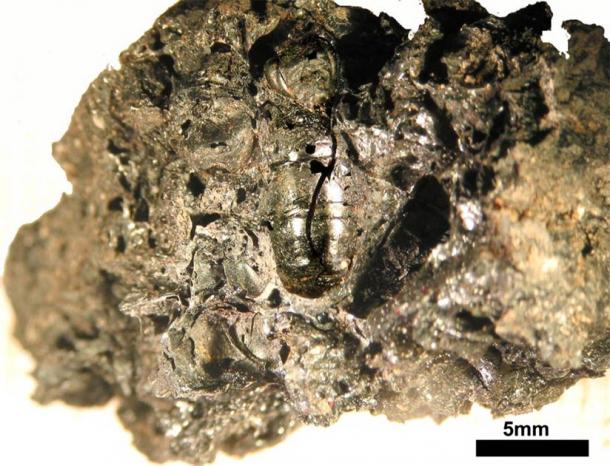
In 2017, scientists discovered the charred remains of honeycombs, honeybees and honeybee products in an ancient Etruscan workshop designed for the harvesting and production of honey. Their subsequent analysis led to their belief that this unique culture used Etruscan bee boats in their production of honey. ( Lorenzo Castellano / Live Science)
Due to the unique nature of transporting beehive boats to aquatic vegetation, the type of honey that was produced tasted like nothing that currently exists. The 2,500-year-old enigmatic Etruscan creation of grapevine honey gave rise to an alternate method for manufacturing beeswax, honey, and other various products.
Although the Etruscan discovery is revolutionary, the desire for honey reflects humanity’s obsession with its properties. Revealing the Etruscans’ practical method has given rise to the significance and trade of the sugary nectar. So to understand its importance, it is best to comprehend its significance to humanity throughout history.
Human History and its Love of Honey
Humanity has been captivated with honey for the last 9,000 years of civilization. In the beginning, the harvesting of honey resulted in the destruction of bee colonies, as honeycombs would be pulled from the hive and then broken, torn, and smashed by humans who hungered for its nectar. The process was clumsy, unhygienic, and extremely destructive. In the millennia to come, humanity honed their honey collecting skills to develop smoke techniques which served to stun the bees without killing them during harvesting, which resulted in creating artificial homes for the hives and sleeves for the combs. In essence, as humanity pioneered agriculture and domestication, their newly acquired skills resulted in the taming and control of beehives themselves.
The traces for their adoration of the golden nectar is evident in the remnants of beeswax found in pottery, ancient beekeeping workshops, and art across ancient Central Europe, Greece, Romania, Serbia Turkey, the Near East, and North Africa. As mentioned by scholars of antiquity, such as Greece’s Aristotle, Rome’s Virgil, Gaius Julius Hyginus, Varro, and Columella, beekeeping was a prominent industry that held great esteem and was honored as a highly valued commodity. One of the most desirable traits of honey is that, because of its antibacterial composition, honey can last almost indefinitely without rotting or going bad. In several archaeological excavations in Egypt, archaeologists have discovered ceremonial jars of honey not only intact, but with leftover honey!
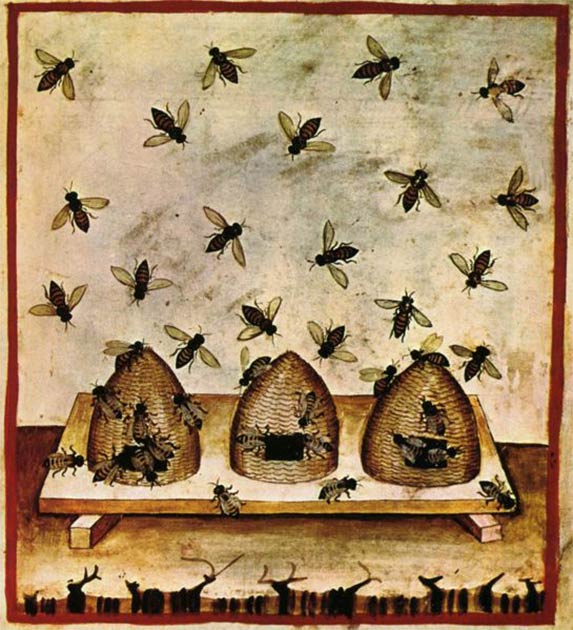
Beekeeping as depicted in the Tacuinum Sanitatis, an Arab medical text by Ibn Butlan of Baghdad, describing the benefits and harmful effects of different foods and plants. ( Public domain )
Honey has even been associated with ancient medicines responsible for healing liver issues, gastrointestinal irritation, and cardiovascular concerns. Ancient beeswax may have also been used as an early adhesive for fusing arrow points to spears and making waterproof sealing for tools and boats. Honey not only acted as a food, but it was also used as an antiseptic for wounds, candle making, in religious spells, and even in preventing miscarriages.
Pharaonic honey was used in the embalming process and found in jars among the tombs of the royal, wealthy, and privileged. In Egypt’s history, it was written that Ramses III offered 21,000 jars of honey to the God of the Nile, Hapi. In ancient China, beekeeping was discussed in great detail by Fan Li when describing its collection techniques, its scrutiny for quality, and the appropriate seasons for its processing and harvesting.
Even on the other side of the world, there has been evidence of ancient Mayans caring and conserving bees’ hives for their golden nectar. Although there is no end of iconography, myths and legends, and art dedicated to the importance of honey, a dearth of archaeological information exists as to how ancient people housed and collected bee honey.
What is clear is that at some point in human’s 9,000-year obsession with honey, a brave few attempted to gather wild bees to create artificial hives from pottery vessels, baskets, carved tree logs, and wooden crates to house and utilize them and collect the sappy droplets of their labor. Any archaeological evidence found regarding the evolution of beekeeping is crucial. This is why Dr. Castellano’s discovery of an Etruscan beekeeping workshop is extremely important.
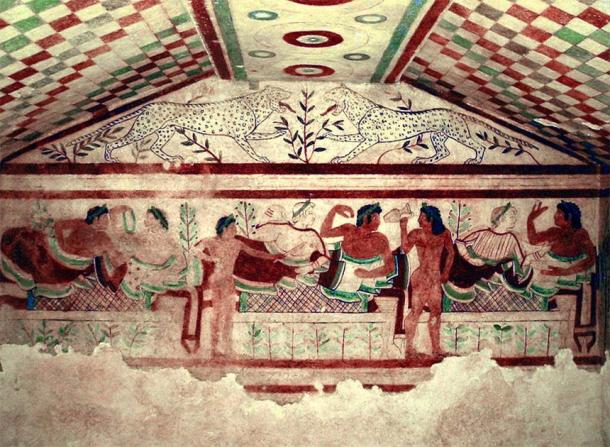
The ancient Etruscans made use of wild grapes to create the earliest form of wine. Researchers believe that they used the pollen of wild grapevines in their honey cultivation. ( Public domain )
The Etruscan Bee Boat Hypothesis
In the ancient world, wild grapes grew rampant throughout the shorelines of the Mediterranean. The Etruscans made use of them by cultivating them for creating the earliest forms of wine. Currently, researchers have revealed that wild grapes and their vines were also used for their pollen in the process of making honey. Because of the prominence of grapevine cultivation and honey, trade routes depended on the production of both goods throughout Central Europe, the Near East, the Middle East, and Greece.
The pollen samples studied by Castellano’s team reveal that the pollen was extracted from grapevines and water lilies that were not native to the Forcello region. Because of the lengthy distance and the evidence revealing honeycombs with the remains of bees, Castello’s team surmised that the hives had to have been moved to the location by boat.
As Castellano’s finding discusses, the beekeeping process during the early Iron Age of Northern Italy revealed great insights into the beekeeping division of labor. In Castellano’s Forcello site, among the ruins of a workshop floor he found thousands of charred remains of honeycombs, honey bees’ fossils, and interestingly enough, preserved honey bee products that have survived the unforgiving tests of time. The ancient Etruscan site’s excavation revealed that the workshop fell victim to a fire and brought it to ruins. The remaining plot was then covered over with a thick layer of clay so that other buildings would be built on top of the burned foundation. Fortunately for the artifacts, the thick clay aided in their preservation process.
Further analysis of the charred and melted honeycombs was beneficial to Castellano’s team since they could isolate specific pollen content. The pollen proved to be collected from aquatic vegetation of wild shoreline grapevines and water lilies. This has confirmed ancient literature from the ancient Roman scholar Pliny the elder, who claimed that:
“The ostiglia villagers simply placed the hives on boats and carried them 5 miles upstream at night” (Lorenzi, 2017).
In Dr. Castellano’s study of Pliny’s work, he mentioned that if the Etruscans indeed used bee boats, they would have set the boats out at dawn and paddled them close to the desired locations of lilies and grapevines. Once placed, the ancient boatmen may have taken a separate raft back to shore and the bees would have been left to harvest for an entire day.
Once the hive was filled with honey, the newly added weight would change the buoyancy of the boat. This would indicate to the beekeepers that the boat was fully loaded with honey and that the was ready to return to the workshop for honey extraction. Pliny’s literature provided a vivid depiction as to how bee boats may have been utilized. With Dr. Castellano’s newfound data and analysis of aquatic plant pollen, Pliny’s historic account of Etruscan bee boats currently carries more weight in the world of archaeology.
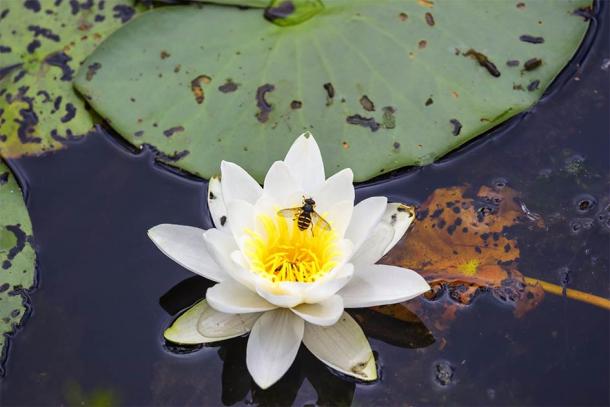
The researchers argue that beekeepers placed the hives on boats so the bees could harvest pollen from aquatic vegetation such as wild shoreline grapevines and water lilies. ( Lars Johansson / Adobe Stock)
The Modern Flavors Made by Dying Bees
As Dr. Castellano has mentioned in several interviews, “grapevine honey has nothing to do with bee-produced honey, but rather it is a kind of syrup produced by boiling grape juice” (Lorenzi, 2017). The names and meanings may have changed over the eons since the Etruscans existed, but the desire to create unique-tasting honey has returned into fashion.
But questions remain as to why wild lilies and grapevines were used in Etruscan honey production. Was this because the honey was specifically used for the creation of honey wine or what would today be known as mead? Or were there medical properties that were tied to using grapevine honey? After all, grapevines and wine were already used for multiple purposes, ranging from casual alcoholic drinks to the disinfecting of soldier wounds.
Though the exact taste may be lost due to the extinction of wild preindustrial grapevines and lilies, perhaps comparing with contemporary counterparts may give answers to the ancient ways. In contemporary times, many beekeepers make sure to keep ponds and freshwater sources close to a hive. A good source of clean water leads to a strong hive and richer honey production. What effectively helps in the foraging of clean water are using lily pads for platforms. Perhaps the Etruscans knew this and purposely planted their bee boats near water sources rich in lily pads, not for the sake of its pollen but to aid bees in landing and harvesting water for the colony to hydrate.
As for the taste of wild grapevine honey, it may be that the Etruscans understood the benefits of exclusively placing the hive in areas growing particular flowers and plants. Given the strong connection between wild grapevines in the ancient world and wine, there may be an association for wine pairings and flavorings from the grapevine honey the Etruscans created. If this is the case, then it is indeed a technique that has gone underappreciated for several thousand years.
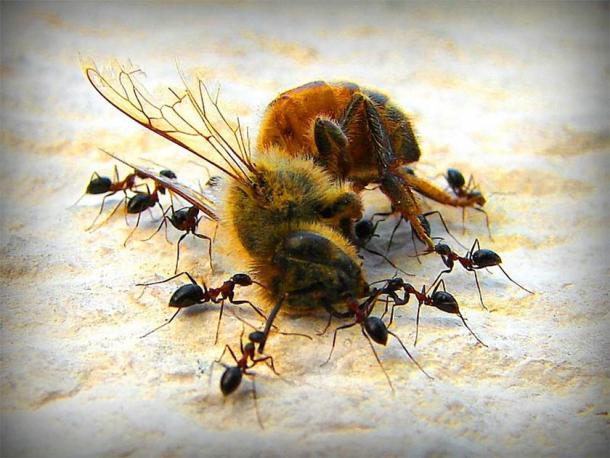
These days, due to the massive amounts of pesticides used in industrial agriculture, bees have been dying in droves, and many fear for the future of bees and beekeeping. (Hamed Saber / CC BY 2.0 )
In the current era, most store-bought honey is mixed from several hives across the country. There has been a growing desire to attain the tastes of various plants. Modern beekeeper enthusiasts have made it a novelty for seasonal honey’s made from different kinds of flowers, fruits, and berries. This particular brand is known as univarietal honey, which is dominated by only one kind of pollen to give it a unique taste.
Currently, many univarietal honey flavors exist. These flavors range from pollen and sap harvested from blueberry, buckwheat, lavender, sunflowers, and rose. Each particular pollen adds a unique color, flavor, and texture to the honey that is produced. With this in mind, perhaps the ancient Etruscans understood plant properties influencing the taste and composure of honey, which is why they used boats to move beehives close to wild grapevines and water lilies. One could only imagine what that concoction would taste like as either a wine or a sweetener.
However, with the current state of bee populations due to climate change, pesticides, and parasites, there is a growing fear among many scientists and beekeeping enthusiasts that honeybees may go extinct. Since 2006, there has been a bizarre occurrence known as Colony Collapse Disorder, which results in the complete demise of both drones and queens, and the severe weakening of larvae that survive. Due to the massive amounts of pesticides used in industrial agriculture, bees have been dying in droves, resulting in certain areas in China having to rely on human hand-pollination techniques to replace the massive loss of bees in their regions.
Several beekeeping movements have started to practice the technique called “natural beekeeping,” which uses compartments allowing for movable combs without the use of frames or foundations. This particular method allows for healthier bees that are not exposed to the ravages of pesticides that may spray over their hives. Additionally, this method has made the spotting of parasites easier when examining the bee combs. Nevertheless, the fate of bees remains uncertain. Hopefully, they can continue producing the golden nectar that has driven human civilization for the last 9,000 years.
Top image: The recent discovery of evidence pointing to the use Etruscan bee boats in the production of honey is verification of humanity’s obsession with beekeeping throughout history. Source: shaiith / Adobe Stock
By B. B. Wagner
References
Apiaries, Glenn. 2011. “Bee Enjoying a Beautiful Water Lily” in Glenn Apiaries . Available at: http://www.glenn-apiaries.com/bee_photos_9.html
Briggs, Helen. 11 November 2015. “Prehistoric Farmers were first beekeepers” in BBC News . Available at: https://www.bbc.com/news/science-environment-34749846
No Name. 12 July 2019. “An Ancient History Bee Practice Saving Melipona Beecheii” in The Bee Effect . Available at: https://bee-effect.co.za/an-ancient-honey-bee-practice-saving-melipona-beecheii/
Ekasetya, Laura. 2016. “Why honeys taste different and how you can learn to appreciate them” in Lurie Garden . Available at: https://www.luriegarden.org/2016/10/14/appreciate-honeys-variety/
Lorenzi, Rossella. 28 July 2017. “The Etruscans were Expert Beekeepers, Ancient Honeycombs Suggest” in Live Science . Available at: https://www.livescience.com/59970-etruscans-were-expert-beekeepers.html
Oskouei, Tehereh Eteraf and Moslem Najafi. 2013. “Traditional and Modern Uses of Natural Honey in Human Diseases: A review” in Iran J Basic Medical Science Magazine 16 (6). Available at: https://www.ncbi.nlm.nih.gov/pmc/articles/PMC3758027/#:~:text=The%20ancient%20Egyptians%20offered%20honey,a%20topical%20ointment%20(31)
Terracotta, Blue. 28 June 2010. “The Honey Bee in the Ancient world” in Blue Terracotta . Available at: https://blueterracotta.com/blogs/news/the-honey-bee-in-the-ancient-world
Urbanus, Jason. December 2017. “Itinerant Etruscan Beekeepers” in Archaeology. Available at: https://www.archaeology.org/issues/275-1711/from-the-trenches/6004-trenches-etruscan-beekeeping
Zissou, Alexandra. 31 December 2015. “The Buzz about colony collapse disorder” in NRDC. Available at: https://www.nrdc.org/stories/buzz-about-colony-collapse-disorder?gclid=Cj0KCQiA48j9BRC-ARIsAMQu3WQRUzX_Fp1-TJlRQYH3Egy4ESMJtfN-Zl5tVXAcWMM_iDbTI6UNVKQaAlpSEALw_wcB
Related posts:
Views: 0
 RSS Feed
RSS Feed















 November 24th, 2020
November 24th, 2020  Awake Goy
Awake Goy  Posted in
Posted in  Tags:
Tags: 
















